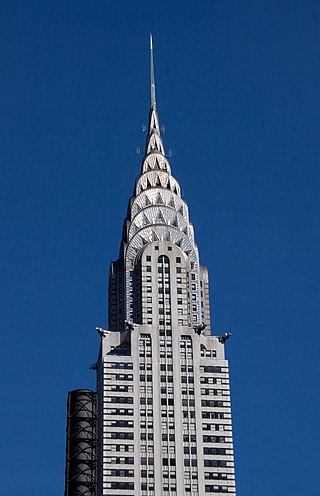
Art Deco, short for the French Arts décoratifs, is a style of visual arts, architecture, and product design, that first appeared in Paris in the 1910s, and flourished in the United States and Europe during the 1920s to early 1930s. Through styling and design of the exterior and interior of anything from large structures to small objects, including how people look, Art Deco has influenced bridges, buildings, ships, ocean liners, trains, cars, trucks, buses, furniture, and everyday objects including radios and vacuum cleaners.

The Palacio de Bellas Artes is a prominent cultural center in Mexico City. This hosts performing arts events, literature events and plastic arts galleries and exhibitions. "Bellas Artes" for short, has been called the "art cathedral of Mexico", and is located on the western side of the historic center of Mexico City which is close to the Alameda Central park.
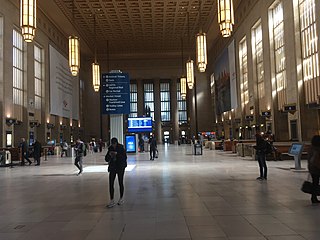
Interior design is the art and science of enhancing the interior of a building to achieve a healthier and more aesthetically pleasing environment for the people using the space. With a keen eye for detail and a creative flair, an interior designer is someone who plans, researches, coordinates, and manages such enhancement projects. Interior design is a multifaceted profession that includes conceptual development, space planning, site inspections, programming, research, communicating with the stakeholders of a project, construction management, and execution of the design.

The Pellissier Building and adjoining Wiltern Theatre is a 12-story, 155-foot (47 m) Art Deco landmark at the corner of Wilshire Boulevard and Western Avenue in Los Angeles, California. The entire complex is commonly referred to as the Wiltern Center. Clad in a blue-green glazed architectural terra-cotta tile and situated diagonal to the street corner, the complex is considered one of the finest examples of Art Deco architecture in the United States. The Wiltern building is owned privately, and the Wiltern Theatre is operated by Live Nation's Los Angeles division.

Colón is a municipality and city in the Matanzas Province of Cuba. The municipality has an area of 547 km2 (211 sq mi) and a population of about 68,021. The city proper, with a population of about 44,000, is the third-largest of its province.

Mayan Revival is a modern architectural style popular in the Americas during the 1920s and 1930s that drew inspiration from the architecture and iconography of pre-Columbian Mesoamerican cultures.

John Adolph Emil Eberson was an Austrian-American architect best known for the development and promotion of movie palace designs in the atmospheric theatre style. He designed over 500 theatres in his lifetime, earning the nickname "Opera House John". His most notable surviving theatres in the United States include the Tampa Theatre (1926), Palace Theatre Marion (1928), Palace Theatre Louisville (1928), Majestic Theatre (1929), Akron Civic Theatre (1929), the Paramount Theatre (1929), the State Theater 1927, and the Lewis J. Warner Memorial Theater (1932) at Worcester Academy in Worcester, Massachusetts. Remaining international examples in the atmospheric style include both the Capitol Theatre (1928) and State Theatre (1929) in Sydney, Australia, The Forum and Le Grand Rex.
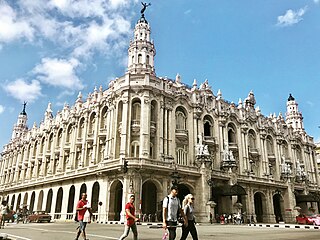
Gran Teatro de La Habana is a theater in Havana, Cuba, home to the Cuban National Ballet. It was designed by the Belgian architect Paul Belau and built by Purdy and Henderson, Engineers in 1914 at the site of the former Teatro Tacón. Its construction was paid for by the Galician immigrants of Havana to serve as a community-social center. Located in the Paseo del Prado, its facilities include theatres, a concert hall, conference rooms, a video screening room, as well as an art gallery, a choral center and several rehearsal halls for dance companies. It hosts the International Ballet Festival of Havana every two years since 1960.

The Teatro Nacional de Cuba is a theatre building in Havana, Cuba, on Plaza de la Revolución.

The Gran Hotel Manzana Kempinski La Habana is a luxury hotel in Havana, Cuba. It is located in the historic Manzana de Gómez building, an early-20th-century building that was Cuba's first shopping mall. The Kempinski Hotel chain, belongs to the oldest hotel groups in Europe, Kempinski Aktiengesellschaft.

The Teatro Gran Rex is an Art Deco style theatre in Buenos Aires, Argentina which opened on July 8, 1937, as the largest cinema in Argentina.
The Teatro Opera is a prominent cinema and theatre house in Buenos Aires, Argentina.

The Bacardi Building is an Art Deco Havana landmark designed by the architects Esteban Rodríguez-Castells and Rafael Fernández Ruenes and completed in 1930. It is located on the corner of Calles Monserrate and San Juan de Dios on a 1,320 m2 (14,200 sq ft) lot in Las Murallas, Old Havana.

The Malek Theatre, also known as The Malek, is an Art Deco theatre in downtown Independence, Iowa that was built in 1947. It replaced the Grand Theatre, which had burned on March 3, 1945. It was designed by Wetherell & Harrison for Bob C. Malek and was intended to be fireproof. It has a steel truss roof. A stepped tower at the front is made with structural glass and glass blocks. As of 2009 the interior was mostly original, with Art Deco style light fixtures and coved ceilings. Artist Merle Reed, of California, hand-painted its interior designs in 1945.
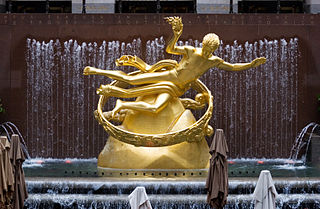
The Art Deco style, which originated in France just before World War I, had an important impact on architecture and design in the United States in the 1920s and 1930s. The most notable examples are the skyscrapers of New York City, including the Empire State Building, Chrysler Building, and Rockefeller Center. It combined modern aesthetics, fine craftsmanship, and expensive materials, and became the symbol of luxury and modernity. While rarely used in residences, it was frequently used for office buildings, government buildings, train stations, movie theaters, diners and department stores. It also was frequently used in furniture, and in the design of automobiles, ocean liners, and everyday objects such as toasters and radio sets.
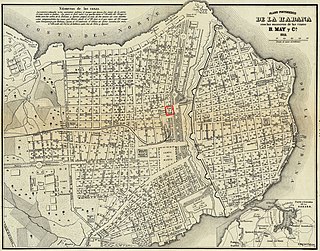
The Teatro Tacón opened in 1838 in Havana, Cuba. Its auditorium contained 2,750 seats. It was built by Pancho Martí, a businessman from Barcelona who moved to Havana, and named after Miguel Tacón y Rosique, Governor of Cuba from 1834 to 1838. In 1847 Bottesini's opera Cristoforo Colombo premiered there. By 1855, so many people attended events that the city issued parking regulations for carriages on performance nights.

Architecture of Cuba refers to the buildings, structures and architectural history throughout the Caribbean island nation of Cuba. The unique mix of cultural and artistic influences throughout history have led to Cuba being renowned for its eclectic and diverse architecture, which can be defined as a unique fusion of numerous well-studied architectural styles from around the world.

The Art Deco movement of architecture and design appeared in Paris in about 1910–12, and continued until the beginning of World War II in 1939. It took its name from the International Exposition of Modern Decorative and Industrial Arts held in Paris in 1925. It was characterized by bold geometric forms, bright colors, and highly stylized decoration, and it symbolized modernity and luxury. Art Deco architecture, sculpture, and decoration reached its peak at 1939 Exposition Internationale des Arts et Techniques dans la Vie Moderne, and in movie theaters, department stores, other public buildings. It also featured in the work of Paris jewelers, graphic artists, furniture craftsmen, and jewelers, and glass and metal design. Many Art Deco landmarks, including the Théâtre des Champs-Élysées and the Palais de Chaillot, can be seen today in Paris.
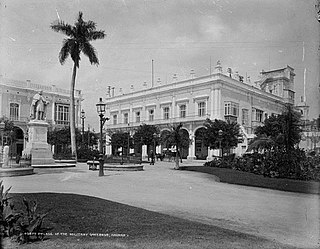
The Palacio del Segundo Cabo was built in the last decades of the 18th century, between 1770 and 1791, as part of the urban improvement project around the Plaza de Armas.

Fernando Tarazona was a Spanish-born painter who lived much of his life in exile, in Cuba. He was one of the first painters in the world to focus on Afro-Cubans as his principal subject matter. Many of these works depicted Magical realism and Spirituality. He also painted landscapes and portraits. Many Spaniards remember him today as an exiled scenographer.




















